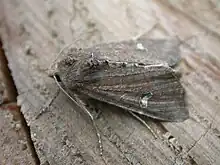| Helotropha leucostigma | |
|---|---|
 | |
| Scientific classification | |
| Domain: | Eukaryota |
| Kingdom: | Animalia |
| Phylum: | Arthropoda |
| Class: | Insecta |
| Order: | Lepidoptera |
| Superfamily: | Noctuoidea |
| Family: | Noctuidae |
| Genus: | Helotropha |
| Species: | H. leucostigma |
| Binomial name | |
| Helotropha leucostigma (Hübner, 1808) | |
| Synonyms | |
| |
Helotropha leucostigma, the crescent, formerly Celaena leucostigma is a moth of the family Noctuidae. It is found in the Palearctic realm (Europe, Russia,[1] Armenia, Turkestan, Siberia, Russian Far East, Mongolia, Amur, Korea, Japan, and northeastern China).

Technical description and variation
The wingspan is 37–44 millimetres (1.5–1.7 in). Forewing dull dark brown, faintly reddish- tinged; the veins powdered with grey scales; the terminal area beyond subterminal line black-brown, except at apex: median area between subcostal vein and vein 1 somewhat darker than the rest of wing; inner and outer lines indistinctly double: the inner outwardly oblique, the outer bent on vein 5; claviform stigma hardly visible; orbicular stigma oblique, elliptical, of the ground colour, with paler annulus; the reniform white or dull yellow, containing a double dark lunule with pale centre; the outer edge of this dark inner lunule is sometimes obsolete, in which case the stigma appears more solidly yellowish or white; the space between outer and subterminal lines is always slightly, often visibly, paler than the ground colour; hindwing fuscous grey; — in the ab. lunina Haw. the outer fascia is conspicuously paler, becoming pale brown or pinkish ochreous, the median vein and veins 3, 4 at their base are white, and both stigmata are more strongly marked; ab. albipuncta Tutt is comparatively a rare form, with nearly the whole reniform stigma snow-white; — fibrosa Hbn. represents a bright reddish fulvous form, which may exist, but which no one appears to have seen; — laevis Btlr. the Japanese form, is, as usual, larger than the European, and the outer line appears rather more strongly excurved beyond cell and incurved below.[2]

Biology
The moth flies from June to October depending on location.
Larva blackish-brown; the dorsal and subdorsal lines somewhat paler; thoracic and anal plates blackish; head brown. The larvae feed on waterplants Iris pseudacorus and Cladium mariscus.[3]
References
- ↑ "Helotropha leucostigma (Hübner, 1808)". Fauna Europaea. 2.6.2. August 29, 2013. Archived from the original on October 21, 2014. Retrieved January 5, 2014.
- ↑ Seitz, A. Ed., 1914 Die Großschmetterlinge der Erde, Verlag Alfred Kernen, Stuttgart Band 3: Abt. 1, Die Großschmetterlinge des palaearktischen Faunengebietes, Die palaearktischen eulenartigen Nachtfalter, 1914
- ↑ "Robinson, G. S., P. R. Ackery, I. J. Kitching, G. W. Beccaloni & L. M. Hernández, 2010. HOSTS – A Database of the World's Lepidopteran Hostplants. Natural History Museum, London".